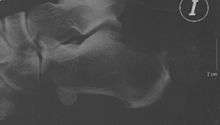Haglund's deformity
Haglund's deformity (also referred to as Mulholland deformity, retrocalcaneal bursitis, posterior calcaneal tuberosity, and pump bump) is a bony enlargement on the back of the heel that most often leads to painful bursitis, which is an inflammation of the bursa (a fluid-filled sac between the tendon and bone). In Haglund's deformity, the soft tissue near the Achilles tendon becomes irritated when the bony enlargement rubs against shoes.
Haglund's deformity is often called "pump bump" because the rigid backs of pump-style shoes can create pressure that aggravates the enlargement when walking.
Symptoms
Haglund's deformity can occur in one or both feet. The signs and symptoms include:
- A noticeable bump on the back of heel.
- Pain in the area where the Achilles tendon attaches to the heel.
- Swelling in the back of the heel.
- Redness near the inflamed tissue.
Causes
To some extent, heredity plays a role in Haglund's deformity. People can inherit a type of foot structure that makes them prone to developing this condition.
For example, high arches can contribute to Haglund's deformity. The Achilles tendon attaches to the back of the heel bone, and in a person with high arches, the heel bone is tilted backward into the Achilles tendon. This causes the uppermost portion of the back of the heel bone to rub against the tendon. Eventually, due to this constant irritation, a bony protrusion develops and the bursa becomes inflamed. It is the inflamed bursa that produces the redness and swelling associated with Haglund's deformity.
A tight Achilles tendon can also play a role in Haglund's deformity, causing pain by compressing the tender and inflamed bursa. In contrast, a tendon that is more flexible results in less pressure against the painful bursa.
Another possible contributor to Haglund's deformity is a tendency to walk on the outside of the heel. This tendency, which produces wear on the outer edge of the sole of the shoe, causes the heel to rotate inward, resulting in a grinding of the heel bone against the tendon. The tendon protects itself by forming a bursa, which eventually becomes inflamed and tender.
Diagnosis
After evaluating the patient's symptoms, the foot and ankle surgeon will examine the foot. In addition, x-rays will be requested to help the surgeon evaluate the structure of the heel bone.

Treatment
Non-surgical treatment of Haglund's deformity is aimed at reducing the inflammation of the bursa. While these approaches can resolve the bursitis, they will not shrink the bony protrusion. Non-surgical treatment can include one or more of the following:
- Removal of the problem: Walking without shoes takes the pressure completely off the affected area.
- Medication. Anti-inflammatory medications may help reduce the pain and inflammation. Some patients also find that a topical pain reliever, which is applied directly to the inflamed area, is beneficial.
- Ice. To reduce swelling, apply a bag of ice over a thin towel to the affected area for 20 minutes of each waking hour. Do not put ice directly against the skin.
- Exercises. Stretching exercises help relieve tension from the Achilles tendon. These exercises are especially important for the patient who has a tight heel cord.
- Heel lifts. Patients with high arches may find that heel lifts placed inside the shoe decrease the pressure on the heel.
- Shoe modification. Wearing shoes that are backless or have soft backs will avoid or minimize irritation.
- Physical therapy. A physical therapist can help identify biomechanical abnormalities that may be contributing to inflammation and recommend appropriate strengthening and stretching exercises to help decrease discomfort and prevent the need for surgery.
- Orthotic devices. These custom arch supports are helpful because they control the motion in the foot, which can aggravate symptoms.
- Immobilization. In some cases, casting may be necessary to reduce symptoms.
If non-surgical treatment fails to provide adequate pain relief, surgery may be needed consisting of debridement of the affected Achilles tendon and excision of the retrocalcaneal bursa and the Haglund deformity. A central approach facilitates such debridement but necessitates detachment of 50% of the Achilles tendon from the calcaneus which is usually sutured back using bone anchors. In severe cases necessitating debridement of a substantial portion of the Achilles tendon, augmentation may be done with the transfer of the flexor hallucis longus muscle.
Prevention
A recurrence of Haglund's deformity may be prevented by:
- Wearing appropriate shoes; avoid pumps and high-heeled shoes.
- Using arch supports or orthotic devices.
- Performing stretching exercises to prevent the Achilles tendon from tightening.
- Avoiding running on hard surfaces and running uphill.